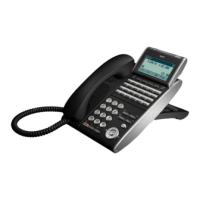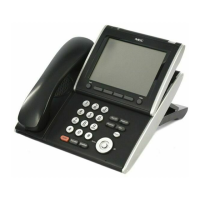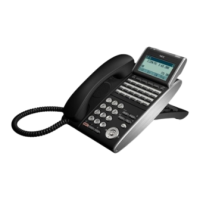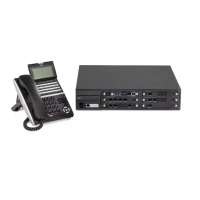Program Num-
ber
Program Name Default
22-11-02 DID Translation Number Conversion - Target Num-
ber
Refer to Programming Manual.
80-01-01 Service Tone Setup - Tone 44, External Dial Tone 0~255
(0 ... Endless)
80-01-01 Service Tone Setup - Tone 57, Off-Hook Beep Tone -
Headset Earpiece ringing Tone
Refer to Programming Manual.
80-03-01 DTMF Tone Receiver Setup - Detect Level Type 1~5 = 0
80-03-03 DTMF Tone Receiver Setup - Min. Detect Level Type 1 = 10 (-20dBm)
Type 2 = 15 (-25dBm)
Type 3 = 10 (-20dBm)
Type 4 = 10 (-20dBm)
Type 5 = 10 (-20dBm)
Operation
With any feature, if the Mobile Extension user presses
, an existing call is placed in hold. Pressing
a second time or the timeout of the inter-digit timer returns the call to conversation mode.
Using Analog Lines with the Mobile Extension
Analog lines can be used for integration with the Mobile Extension using either DILs or VRS Auto
Attendant to access the Mobile Extension Proxy Port. However, it must be noted that the
0 Hang Up
code must be used prior to terminating any call (e.g., transfer, hang up etc.) as analog trunks do not
provide Disconnect Supervision.
Placing an Intercom Call to a Mobile Extension:
1. Lift the handset or press SPK.
2. Dial the extension number assigned to the Mobile Extension.
If the Mobile Extension is turned off, incoming calls hear a message indicating the user is not
available. The setting in the DTMF Confirmation programming (PRG 15-22-02) determines how
the call is handled.
PRG 15-22-02 set to 0 or 1 (DTMF Confirmation Required):
The caller is retrieved by the SL1000/SL1100 and follows the no-answer programming (ring
another extensions, forward to SL1000/SL1100 voice mail, etc.)
PRG 15-22-02 set to 2 (No DTMF Confirmation Required):
The caller is forwarded to the external extension voice mail, if available.
Outside Party Dialing the Mobile Extension:
1. Dial the DID or DIL telephone number for the Mobile Extension.
2. System programming (DID=22-11-01 or DIL=22-07-01) must be defined.
If the Mobile Extension is turned off, incoming callers hear a message indicating the user is not
available. The setting in the DTMF Confirmation programming (PRG 15-22-02) determines how
the call is handled.
PRG 15-22-02 set to 0 or 1 (DTMF Confirmation Required):
The caller is retrieved by the SL1000/SL1100 and follows the no-answer programming (ring
another extension, forward to SL1000/SL1100 voice mail, etc.)
PRG 15-22-02 set to 2 (No DTMF Confirmation Required):
The caller is forwarded to the external extension voice mail, if available.
ISSUE 2.0
SL1000/SL1100
Features and Specifications Manual 1-491
M

